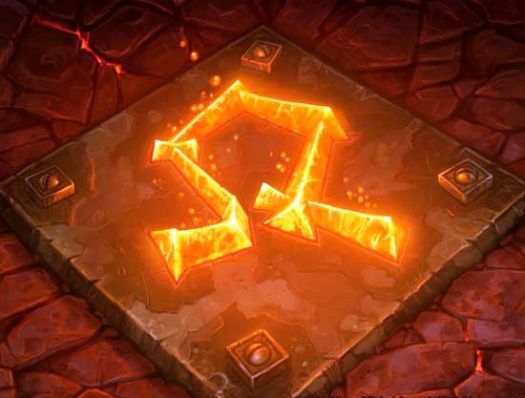Difference between revisions of "Glyph of Warding (spell)"
Tao alexis (talk | contribs) |
|||
| (4 intermediate revisions by 2 users not shown) | |||
| Line 1: | Line 1: | ||
| + | [[File:Glyph of Warding (spell).jpg|right|525px|thumb]] | ||
| + | '''Glyph of warding''' inscribes a hieroglyphic character or symbol upon an object or surface which, if disturbed, will discharge the stored dweomer within. The caster chooses the effect from among his or her existing spell list; for example, the glyph could set off a [[Remove Curse (spell)#Curse|curse]], [[Neutralise Poison (spell)#Suffuse with Poison|suffuse with poison]] or a [[Flame Strike (spell)|flame strike]] ... even something positive like [[Cure Light Wounds (spell)|cure light wounds]] or [[Bless (spell)|bless]]. | ||
| + | |||
{{Spelltable | {{Spelltable | ||
| name = Glyph of Warding | | name = Glyph of Warding | ||
| range = touch | | range = touch | ||
| duration = until discharged | | duration = until discharged | ||
| − | | area of effect = 5 ft. + 2 ft. per level circle | + | | area of effect = 5 ft. + 2 ft. per [[Experience Level|level]] circle |
| − | | casting time = 2 rounds | + | | casting time = 2 [[Combat Round|rounds]] |
| save = special | | save = special | ||
| level = [[Cleric 3rd Level Spells|cleric (3rd)]] | | level = [[Cleric 3rd Level Spells|cleric (3rd)]] | ||
}} | }} | ||
| − | + | To create the glyph, the caster first casts "glyph of warding," then immediately and without hesitation, the second dweomer is invested into the glyph. If the second spell is [[Spellcasting|ruined]], then both spells will fail. | |
| + | |||
| + | == Discharge == | ||
| + | Once the glyph's inscribed, the object that's altered cannot be moved or carried around; if it's moved at all, opened, adjusted or pressed hard, it will enact its magic. With permanent surfaces, such as a floor, wall or railing, passing within 5 ft. of the glyph, or within the [[Combat Hex|combat hex]] it occupies, is sufficient to set it off. | ||
| + | |||
| + | ==== Effect ==== | ||
| + | The consequence of the spell's magic is defined by the glyph, not the stored spell's normal area of effect and range. The power of the magic equals the caster's level at the time the glyph was inscribed. With regards to positive effects, where the spell would normally require "belief," recipients must be of the caster's religion to gain benefits. | ||
| + | |||
| + | == Number of Glyphs == | ||
| + | The caster may create one glyph per level, and no more than one glyph per day. Thus, a 7th level caster would be able to steadily manufacture seven glyphs over the space of a week. Thereafter, no new glyphs could be cast at all, unless some previously made glyph were dispelled at the caster's will — however, the caster must touch the glyph to dispel it. | ||
| − | + | As such, the caster decides which glyph to dispel. If no glyph is within reach to be dispelled, the caster must do without. Once a glyph is discharged by some other being, the caster is free to replace it. | |
| − | |||
| − | + | See [[Wizard Mark (spell)]] | |
| − | + | [[Category: Clerical Spells]][[Category: Don't Review until 2023]] | |
| − | |||
Latest revision as of 21:05, 5 January 2022
Glyph of warding inscribes a hieroglyphic character or symbol upon an object or surface which, if disturbed, will discharge the stored dweomer within. The caster chooses the effect from among his or her existing spell list; for example, the glyph could set off a curse, suffuse with poison or a flame strike ... even something positive like cure light wounds or bless.
| Range | touch |
| Duration | until discharged |
| Area of Effect | 5 ft. + 2 ft. per level circle |
| Casting Time | 2 rounds |
| Saving Throw | special |
| Level | cleric (3rd) |
To create the glyph, the caster first casts "glyph of warding," then immediately and without hesitation, the second dweomer is invested into the glyph. If the second spell is ruined, then both spells will fail.
Discharge
Once the glyph's inscribed, the object that's altered cannot be moved or carried around; if it's moved at all, opened, adjusted or pressed hard, it will enact its magic. With permanent surfaces, such as a floor, wall or railing, passing within 5 ft. of the glyph, or within the combat hex it occupies, is sufficient to set it off.
Effect
The consequence of the spell's magic is defined by the glyph, not the stored spell's normal area of effect and range. The power of the magic equals the caster's level at the time the glyph was inscribed. With regards to positive effects, where the spell would normally require "belief," recipients must be of the caster's religion to gain benefits.
Number of Glyphs
The caster may create one glyph per level, and no more than one glyph per day. Thus, a 7th level caster would be able to steadily manufacture seven glyphs over the space of a week. Thereafter, no new glyphs could be cast at all, unless some previously made glyph were dispelled at the caster's will — however, the caster must touch the glyph to dispel it.
As such, the caster decides which glyph to dispel. If no glyph is within reach to be dispelled, the caster must do without. Once a glyph is discharged by some other being, the caster is free to replace it.
